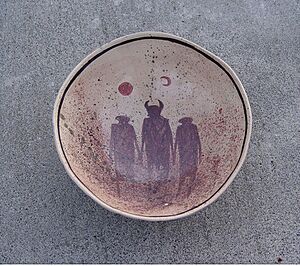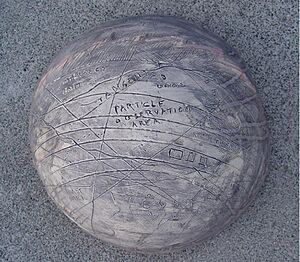Carl Beam facts for kids
Quick facts for kids
Carl Beam
|
|
|---|---|
| Born |
Carl Edward Migwans
May 24, 1943 |
| Died | July 30, 2005 (aged 62) |
| Resting place | M'Chigeeng First Nation |
| Nationality | Ojibwe |
| Alma mater | University of Victoria, University of Alberta |
| Occupation | Artist |
| Known for | painter, potter, graphic artist |
| Spouse(s) | Ann Elena Weatherby |
| Children | 6, including Anong Beam |
Carl Beam RCA (May 24, 1943 – July 30, 2005), born Carl Edward Migwans, was a very important Canadian artist. He made history as the first artist of Native Ancestry (Ojibwe) to have his artwork bought by the National Gallery of Canada as modern art. This was a big step for Indigenous artists in Canada.
Carl Beam used many different materials in his art. He worked with photographs, mixed materials, oil paints, and acrylics. He also drew on canvas, paper, Plexiglas, stone, cement, and wood. He even made handmade ceramic pottery and used found objects. Besides painting, he also created art using etching, lithography, and screen printing. In 2010, the National Gallery of Canada held a special show of his work.
Contents
Carl Beam's Life
Carl Edward Migwans was born on May 24, 1943. His birthplace was the M'Chigeeng First Nation on Manitoulin Island, Ontario. His father, Edward Cooper, was an American soldier. His mother, Barbara Migwans, was the daughter of Dominic Migwans. Dominic was the Chief of the Ojibways of West Bay (now M'Chigeeng First Nation). The Beam family's real name, miigwaans, means "little feather" or "bird" in the Ojibwe language.
Carl's father died as a prisoner during World War II. Carl was mostly raised by his grandparents. His elders noticed his special talents and gave him the name "Ahkideh." This Ojibwe word means "one who is brave." From age ten to eighteen, Carl went to the Garnier Residential School in Spanish, Ontario.
Carl married his first wife in the early 1960s. They had five children: Clinton, Veronica, Laila, Carl Jr., and Jennifer. Later, this marriage ended. Carl then married Ann Elena Weatherby, who was also an artist. They had a daughter named Anong.
Carl Beam passed away on July 30, 2005. He died at his home on the M'Chigeeng Reserve from problems related to diabetes.
Education and Early Art
Before becoming a full-time artist, Carl Beam worked many different jobs. He helped build the Toronto subway and worked in a mill. In 1971, he started studying art at the Kootenay School of Art. He then earned a Bachelor of Fine Arts from the University of Victoria in 1974. He continued his studies at the University of Alberta from 1975 to 1976. He left the University of Alberta after a disagreement about his ideas on Native art. He then moved back to Ontario.
By the late 1970s, Carl Beam's unique art style was clear. In 1979, he met and married Ann Beam. Ann was also an artist and often worked with Carl. They would talk about art, politics, and world events. Carl started putting many photographic images onto one artwork. He didn't try to make his pictures look deep like old paintings. Instead, he made them flat so different images could "talk" to each other. He used techniques like screen printing, photo-etching, and Polaroid prints for his photos.
Living in the Southwestern United States
In 1980, Carl, Ann, and their baby daughter Anong moved to Arroyo Seco, New Mexico. They lived and worked there for a while. Carl said that living in the Southwest helped him discover Mimbres bowls. These ancient bowls were made by the Anasazi people over 1,000 years ago. He was amazed by their bold and adventurous designs.
Carl and Ann Beam showed their ceramic art together. Their show was called The Painted Pottery of Ann and Carl Beam. It was held at the Maxwell Museum of Anthropology at the University of New Mexico in Albuquerque.
Pottery and Ceramic Art
Carl Beam had studied ceramic pottery in art school. But he felt he couldn't express himself well with clay at first. So, he stopped making pottery for a while. Years later, in 1980, when he was in New Mexico, he became interested again. He saw beautiful Santa Clara pottery and ancient Mimbres bowls.
Ann Beam said that the black pottery from Santa Clara first caught their attention. Carl was excited by the bold designs. He even met a potter named Rose Montaya, who taught him her techniques. Carl learned to find his own clay and paint stones. He experimented with firing pottery outdoors using dried dung or wood. Many of his early pieces broke during these experiments. All his pottery was handmade without a wheel. It was often unglazed and polished with a stone.
Carl's Mimbres bowls were his modern versions of the ancient Anasazi ones. The inside of his bowls was usually smooth and cream-colored. The outside often looked less finished (see Figures 1 and 2). Carl studied many old bowls in museums and books. His new bowls were inspired by the materials and art of the Anasazi. Like the Anasazi, Carl's bowls often had a bold design around the rim. He placed his own unique images in the center.
Carl loved making bowls because they gave him so much freedom. He said a large bowl was "a universe unto itself where anything can happen." He continued to make bowls, snake pots, and other handmade items. He decorated them with his own designs and images. The raven often appeared in his work. This is because "Migwans," his family name, means "feather" or "bird." His art also showed news events, self-portraits, or family themes. Carl also shared his pottery skills with others, including his cousin David Migwans.
Return to Canada
Even though Carl Beam was becoming successful in the United States, he decided to return to Canada in 1983. He felt his art had an important message to share there. His family moved to Peterborough, Ontario.
In 1984, the Thunder Bay Art Gallery asked Carl to create an artwork. He named it Exorcism. This piece was part of a very important exhibition for him. The show was called Altered Egos: The Multi-media Artwork of Carl Beam.
While living in Peterborough, Carl created a series of large etchings. These prints included many images that he later used in his famous work, The North American Iceberg. This artwork was bought by the National Gallery of Canada. This made Carl Beam the first artist of Native ancestry to have his work added to the National Gallery's permanent collection as modern art.
Later Art Style
By the mid-1980s, Carl Beam was using new ways to add photos to his art. He used a heat transfer method he learned from Ann Beam for his paper and Plexiglas works. He also started using photo emulsion and mixed materials on paper and large canvases. His artworks combined images from spiritual, natural, and political worlds. He also added his own poems and math equations.
Carl said his works were like "little puzzles" or "interesting little games." He wanted people to see how everyone is human. He said his art was not just for selling. It was about "intellectual puzzles" and "spiritual freedom."
The Columbus Project
Carl Beam's art then focused on the 500th anniversary of Christopher Columbus's arrival in North America in 1992. He used this event to talk about culture and how history is told. From 1989 to 1992, he created a series of works called The Columbus Project.
This project included images of Columbus, Native peoples, and other important figures. These included Martin Luther King Jr., John F. Kennedy, Albert Einstein, and Abraham Lincoln. He also used Italian Christian art, animals, self-portraits, and technology. The project also had two sculptures: Voyage, a part of Columbus's ship, the Santa Maria, and Ampulleta, a 6-foot-tall (1.8 m) hourglass. There were also video performances.
In 1992, Carl and Ann Beam built an adobe house on Manitoulin Island. This house was like a big art project itself. It was inspired by their experiences with Native American pottery and building styles in the American Southwest. Their life in this house was shown in Carl's exhibition Living in Mother Earth.
The Whale of Our Being
In the early 2000s, Carl Beam created a series of works called The Whale of Our Being. In these artworks, he explored what he saw as a lack of spiritual connection in modern society. This was shown by a huge, ancient whale.
This exhibition featured large photo emulsion works on canvas, sculptures, big paper artworks, and ceramics. It was called Carl Beam: The Whale of Our Being. An art historian named Joan Murray said that Beam's images had become very wide-ranging. She noted that his art had a "dizzying assortment of references." It included images of Einstein, the Hubble Telescope, astronauts, and Sitting Bull.
Carl Beam believed that if an artist had a good idea, they could explore anything in their art.
Crossroads
Carl Beam's last series of artworks was called Crossroads. He worked on it until he passed away in 2005. The name came from a blues song by Robert Johnson.
This work included images of pop stars, scientists, Native leaders, politicians, writers, and musicians. Some musicians were Bob Dylan, Marilyn Manson, Jerry Garcia, and John Lennon. It also featured TV personalities like Martha Stewart, animals, and birds. He completed works on Plexiglas and paper for Crossroads. He was working on a set of etchings when he died.
It's All Relative Exhibition
In 2004, the Canadian Clay and Glass Gallery created a special traveling exhibition. It featured 50 ceramic pieces by Carl Beam, Ann Beam, and their daughter Anong Migwans Beam. This was the first time all three artists showed their work together. It was Carl Beam's last exhibition during his lifetime, and it continues to travel.
Carl Beam's Legacy
Carl Beam was a trailblazer. He was the first artist of Native ancestry to have his work bought by the National Gallery of Canada as modern art in 1986. This opened doors for many other Indigenous artists who came after him. Even though Beam didn't want to be labeled only as a "Native Artist," his art often explored the challenges faced by his people.
Carl Beam brought new ideas to all the art forms he worked in. He was seen as an innovator because he mixed different art practices. This allowed him to use techniques in new ways. Other artists, both Indigenous and non-Indigenous, have learned from his new techniques. He developed his own unique ways of photo-etching and photo-based painting. His strong ideas about politics and everyday life inspired many people.
A major show of his work was put on by the National Gallery of Canada starting in October 2010. This show recognized Carl Beam as one of Canada's most important artists. The exhibition included his paintings, photo-based collages, sculptures, ceramics, and videos.
On May 24, 2020, which would have been his 77th birthday, the Art Canada Institute announced they would publish a book about Carl Beam. His daughter, Anong Beam, is writing the book.
Awards and Honours
- In 2000, Carl Beam became a member of the Royal Canadian Academy of Arts.
- In 2005, he received the Governor General's Award in Visual and Media Arts. This is one of Canada's highest honors for artists.



